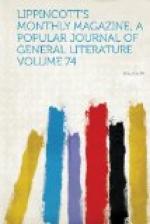Of the minor pictures, that of Dagnan-Bouveret, Un Accident, is one of the best. It is indeed a rare picture in the excellence of its execution in every detail. A boy has been badly wounded in the wrist by some accident, and the surgeon is engaged in dressing the injured part. The dirty foot of the boy as it peeps out beneath the chair, shod in a rough sabot which fails to conceal its grime, the bowl standing on the table half full of blood and water while the wrist is now being skilfully bandaged by the surgeon, whose operations are watched with great solicitude by the group of sympathetic relatives,—all these features give a living interest to this painting which is unusual. The red, grimy hands of the old mother of the boy are very faithfully painted. The expression on the lad’s face of heroic endurance and a determination not to cry in any case is touching.
As for Mademoiselle Sara Bernhardt’s La Jeune Fille et la Mort—a veiled skeleton coming up behind a young girl and touching her on the shoulder—it would attract little attention if it had not been signed by the flighty (and lately fleeing) actress. The verses underneath the picture are the best part of it:
La Mort glisse en son reve, et tout bas:
“Viens,” dit elle,
“L’Amour c’est l’ephemere,
et je suis l’immortelle.”
The great names—Meissonier, Gerome, Munkacsy, Madrazo, Berne-Bellecour, Detaille, De Neuville, Rosa Bonheur, Flameng, etc.—are conspicuous this year by their absence from the catalogue of the Salon. It is whispered that the reason Munkacsy does not exhibit is because the administration of the Beaux-Arts saw fit to place the pictures by foreign artists separately in the Galerie des Etrangers. An “impressionist” artist-friend of mine—Miss Cassatt, the sister of Vice-President Cassatt of the Pennsylvania Railroad Company—says that the reason these distinguished artists do not exhibit any more is that they are disgusted with the way in which the Salon is conducted by Edmond Turquet, the present sous-secretaire aux Beaux-Arts, and the very unfair acts committed in the awarding of medals, admission of pictures, etc.
M. Jean Jacques Henner’s La Fontaine is a true Correggio in delicacy and clearness of tone. His treatment of the flesh is peculiar, and much envied by many a Paris artist. In this picture the nymph, leaning over the fountain, is dressed in a very inexpensive costume—in fact, the same fashion that Mother Eve introduced into Eden. There in the placid water the beautiful creature contemplates the reflection of her face, and seems to breathe, with all her being, those charming lines of Lafenestre:
Heure silencieuse, ou la nymphe se penche
Sur la source des bois qui
lui sert de miroir,
Et reve en regardant mourir sa forme blanche
Dans l’eau pale ou descend
le mystere du soir.




